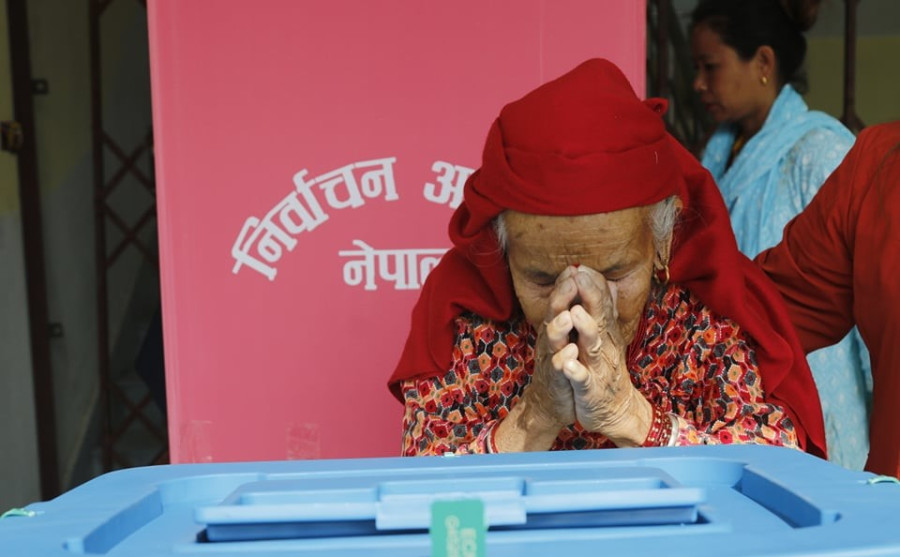Columns
Senior lives matter
This time, let us vote for what we want rather than what everybody else expects us to want.
Poonam Thapa
Nepal has a culture of respecting and caring for the elderly. With modernisation, such perspectives are evolving—positively and negatively—in new and interesting ways.
The Senior Citizens Act of 2006 defines Nepalis who are 60 years and above as one homogenous group of older adults, oblivious to the fact that there are significant physical and mental differences between the genders. Disaggregation by age at each half-decade also remains critical. As we approach each successive zero, our needs and demands for quality services and care change at an accelerated pace while our right to die with dignity remains intact.
Talking from experience, 60 is not the new 50. “Crystallised intelligence”—the ability to recall, reflect on, and reason out pre-existing knowledge, experience, and skills and take action—will be at its peak at sixty. This condition must be recognised at present because most of the extolling of our contributions and virtues always refer to the past. Realistically speaking, the assessment of our abilities and way of life will undoubtedly need to change from time to time, but our self-respect does not have to be solely based on how others younger to us regard us. We should not be constrained by the age of 60, 70 or even 80 because we are worthy of ourselves at any age, especially in our later years. If we are all reasonably healthy and keep our wits, most of us will be alright for some time.
Nepal is projected to be an ageing society by 2028, with seniors accounting for around 19 percent of the 36 million people by 2050. The preliminary census report 2021 has specified that the total population is over 29 million, and nearly 6 percent are 65 years of age and above. There is a difference between the definition of a senior citizen in the Senior Citizens Act of 2006 and the census 2021 ad hoc reporting. It is time to revisit the Senior Citizens Policy 2001 because when the census and the Act came about, the life expectancy of Nepalis was around 61-63 years; it is now about 72, close to the global average. This calls for a review of the 2006 Act and the redefinition of the third stage of life at par with most of the world, which stands at 65. There is a need for action in this situation because the youth-middle age population is shrinking. It will mean rapid adaptations for poorly prepared internal labour markets, a loss in individual tax revenue, and an annual burden on the state coffers.
Section 24 of the Senior Citizens Act of 2006 states that the age for receiving benefits may vary—70 years for all except Dalits, for whom it remains 60 years. The 2008 Senior Citizens Rules focuses on promoting their well-being and sustenance within the family, increasing the universal non-contributary social pension, and providing free primary health care, including geriatric beds in district hospitals. Private sector involvement in licensed care homes, day centres and home service was permitted. Concessions by hospital-clinic-based services and pharmaceutical medicines were also stipulated.
The ceiling for receiving a social pension was lowered from 70 to 65 years in early 2018, then raised to 68 years in mid-2022. There was a time, not so long ago, when women were seen as unproductive and dispensable; their social programmes were often the first to be cut or delayed. In the four years since 2018, finding people who have collected their allowance at 65 or 68 years is difficult. Assisted care in centres or homes is, more often than not, a prime example of unbridled capitalism run amok. As for concessions of any kind in private businesses, it is almost non-existent.
Outside of the Act, the retirement age system also varies by profession and the type of employment in the public or private sector. The overall average is 58 years or 20 years of service. In the private sector, there is the possibility of an annual discretionary extension to a maximum of five years. The question we could be asking is, should healthy people with skills and experience, who wish to continue to be of service, be forced into mandatory retirement by 60 years in any sector? Instead, businesses could better utilise recent retirees to train existing staff, and adult literacy programmes could become more practical in informing seniors about their rights. As for the hundreds of different types of home-based rural or urban enterprises, whether for profit or not for profit, if you are utilising seniors, more power to you, for you are genuinely the custodian of our collective skills and memories.
Social security pension is still beyond the reach of the majority, especially for those in the informal sector and many who lack documented proof of citizenship. For the deprived, the social pension is a lifeline; for the better off, it is a lose-change. If national and provincial budgets are tight, we should rethink universal social pensions, prioritising them to be means-tested and provide a livable amount for those over 65 who are in great need.
Parliament registered a bill in 2019, amending the Act 2006, which proposed that earning children provide 5 to 10 percent of their income to their elderly parents but has not yet passed. Instead, an amendment in 2022 relating to jail sentences and fines for children if elderly parents end up as beggars. It is unsure how this will be within joint families and an entrenched male inheritance system of ancestral properties. An income tax credit/break given to the primary carer—be it a son or daughter—could be more acceptable. The culture of making a will must be encouraged and given legal precedence, possibly helping to turn the tide against the ill-treatment of the elderly. And the direct relationship between youth migration and the elderly descending into poverty needs to be researched to safeguard their fixed assets as well.
Following the enshrinement of constitutional rights for seniors in 2015, successive Nepali governments have sought to strengthen measures for seniors at federal, district and village levels. It has integrated the elderly into risk reduction plans, community welfare committees and funds, police protection services and disaggregated data management and information systems. With no comprehensive monitoring, supervision and evaluation shared with the public, it is hard to say how these interventions play out. The year 2019 saw the change of the Federal Ministry of Women, Children and Social Welfare to the Ministry of Women, Children and Senior Citizens. A name change may be a good start, but it needs to go beyond administrative exercise. Without an active website, there is no public information on structure, staffing relevant data or fact sheets on seniors at the provincial level, nor is there any national advocacy strategy on senior citizen responsive budgeting.
The building blocks are there but far from sufficient. Nepal is a signatory to the UN Principles for Older Persons 1991, Macau Plan of Action on Ageing 1998 and Madrid International PoA on Ageing 2002, including ratification, coordination and reporting regularly. However, in these days of aid fatigue, will donors pay close attention to what is a severe addition to Nepal’s many predicaments? Young Nepalese have historically tended to vote with their feet. With national elections looming, seniors are not going anywhere and are becoming a larger constituency. It is time to fully exercise our rights, ensuring our voices are heard and included in party manifestos, plans and programmes. This time, let us vote for what we want rather than what everybody expects us to want.




 6.59°C Kathmandu
6.59°C Kathmandu















